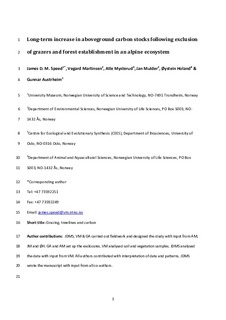| dc.contributor.author | Speed, James David Mervyn | |
| dc.contributor.author | Martinsen, Vegard | |
| dc.contributor.author | Mysterud, Atle | |
| dc.contributor.author | Mulder, Jan | |
| dc.contributor.author | Holand, Øystein | |
| dc.contributor.author | Austrheim, Gunnar | |
| dc.date.accessioned | 2017-11-14T16:18:35Z | |
| dc.date.available | 2017-11-14T16:18:35Z | |
| dc.date.created | 2014-08-22T09:56:19Z | |
| dc.date.issued | 2014 | |
| dc.identifier.citation | Ecosystems (New York. Print). 2014, 17 (7), 1138-1150. | nb_NO |
| dc.identifier.issn | 1432-9840 | |
| dc.identifier.uri | http://hdl.handle.net/11250/2466286 | |
| dc.description.abstract | Ecosystem stores of carbon are a key component in the global carbon cycle. Many studies have examined the impact of climate change on ecosystem carbon storage, but few have investigated the impact of land-use change and herbivory. However, land-use change is a major aspect of environmental change, and livestock grazing is the most extensive land use globally. In this study, we combine a grazing exclosure experiment and a natural experiment to test the impact of grazer exclusion on vegetation dynamics and ecosystem carbon stores in the short term (12-year exclosures), and the long term (islands inaccessible to livestock), in a heavily grazed mountain region in Norway. Following long-term absence of sheep, birch forest was present. The grazing-resistant grass Nardus stricta, dominated under long-term grazing, whilst the selected grass Deschampsiaflexuosa and herb species dominated the vegetation layer in the long-term absence of sheep. The established birch forest led to vegetation carbon stocks being higher on the islands (0.56 kg C m−2 on the islands compared to 0.18 kg C m−2 where grazed) and no difference in soil carbon stocks. In the short-term exclusion of sheep, there were minor differences in carbon stocks reflecting the longer term changes. These results show that aboveground carbon stocks are higher in the long-term absence of sheep than in the continual presence of high sheep densities, associated with a vegetation state change between tundra and forest. The reduction of herbivore populations can facilitate forest establishment and increase aboveground carbon stocks, however, the sequestration rate is low. | nb_NO |
| dc.language.iso | eng | nb_NO |
| dc.publisher | Springer Verlag | nb_NO |
| dc.title | Long-Term Increase in Aboveground Carbon Stocks Following Exclusion of Grazers and Forest Establishment in an Alpine Ecosystem | nb_NO |
| dc.type | Journal article | nb_NO |
| dc.type | Peer reviewed | nb_NO |
| dc.description.version | acceptedVersion | nb_NO |
| dc.source.pagenumber | 1138-1150 | nb_NO |
| dc.source.volume | 17 | nb_NO |
| dc.source.journal | Ecosystems (New York. Print) | nb_NO |
| dc.source.issue | 7 | nb_NO |
| dc.identifier.doi | 10.1007/s10021-014-9784-2 | |
| dc.identifier.cristin | 1148656 | |
| dc.relation.project | Norges forskningsråd: 212897 | nb_NO |
| dc.relation.project | Norges forskningsråd: 179569 | nb_NO |
| dc.description.localcode | © Springer Verlag. This is the authors' accepted and refereed manuscript to the article. The final publication is available at https://link.springer.com/article/10.1007%2Fs10021-014-9784-2 | nb_NO |
| cristin.unitcode | 194,31,10,0 | |
| cristin.unitname | Institutt for naturhistorie | |
| cristin.ispublished | true | |
| cristin.fulltext | postprint | |
| cristin.qualitycode | 2 | |
